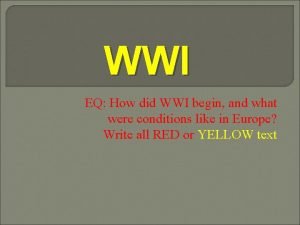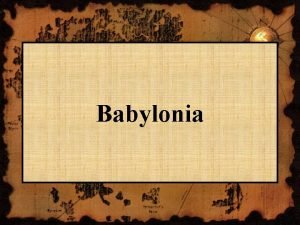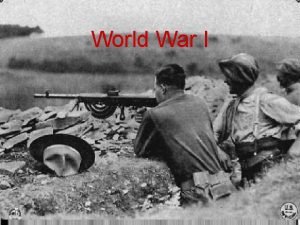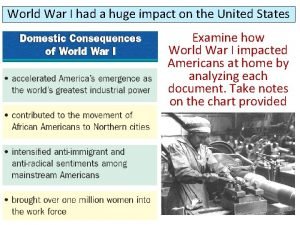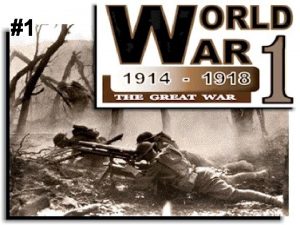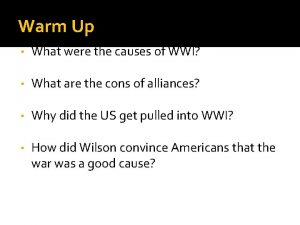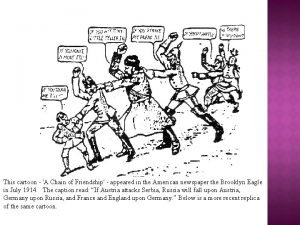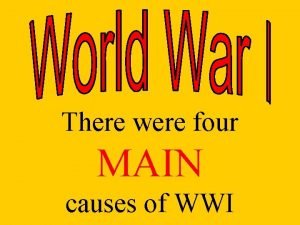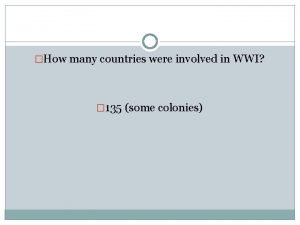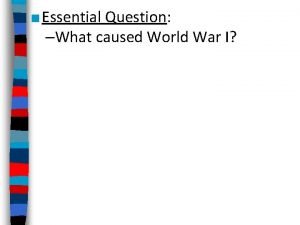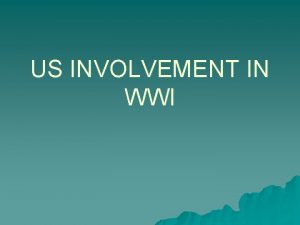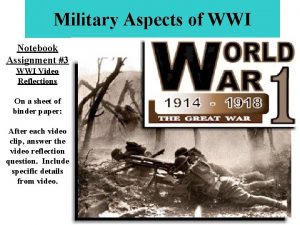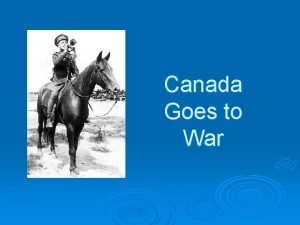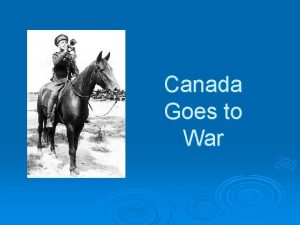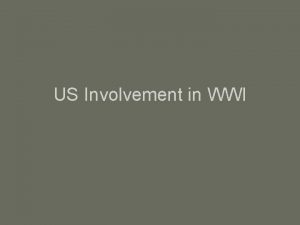WWI Canadas Military Involvement and The Peoples Response




























- Slides: 28

WWI Canada’s Military Involvement and The People’s Response

The Beginning • June 28, 1914: Gavrilo Princip assassinates Archduke Franz Ferdinand, heir to the Austria throne • M. A. N. I. A. • August 4, 1914: G. B. declared war Canada is at war. In 1914 Canada was still a dominion of Great Britain • Great Britain still controlled its Dominions foreign policy • This meant that when Britain went to war Canada, along with the rest of the British Empire, also went to war. • When war was declared people in Canada celebrated in the streets.

Background to WW 1 • At the beginning of the 20 th Century much of Eastern Europe was dominated by three weak and crumbling empires… 1. ) Austro – Hungarian 2. ) Russian 3. ) Ottoman


Background Continued… - Many countries formed alliances to protect themselves. Germany, Austria-Hungary, and Italy formed the Triple Alliance in 1882 France, Russia, and Britain formed an alliance called the Triple Entente 1907

Triple Alliance vs. Triple Entente

Canada’s Military Contribution 1. The Canadian Expeditionary Force: consisted of approximately 600, 000 soldiers 2. The Air Force had approximately 20, 000 personnel. They served under the Royal Flying Corps 3. The Navy had approximately 10, 000 personnel 4. The rest was primarily made up of the infantry or as the British soldiers called them the “PBI”

Royal Aircraft Factory FE 2 d gunner

Command of the Army • At the start of the war Canadian soldiers were under the command of British generals notably: • Field Marshall Douglas Haig who was responsible for ordering many Canadian soldiers to die in battles of attrition. In one example during the Battle of the Somme the Royal Newfoundland Regiment was ordered to advance in error and lost the vast majority of their men. • June 3, 1917: Sir Arthur Currie, a Canadian general, assumes command of the First Canadian Infantry Division Sir Arthur Currie Nicknamed “ Guts and Gaiters - - ->

The Battles These battles signified both the sacrifice and the success of Canadian soldiers in the war: • Victories generated pride amongst soldiers and Canadians at home, improving morale • They also helped foster a sense of Canadian identity and independence from England. • The maple leaf became an internationally recognized symbol of Canadian identity during WWI.

The Battles • 1. Ypres in Belgium: April 1915 • The first battle for Canadian troops. • Chlorine gas is used by the Germans, and 6000 Canadian soldiers are killed. • CBC Archive Clip Remembering Ypres • The second battle at Ypres lasted from April to May 1915. It was the first significant battle that Canadians had spearheaded. • Ypres marked the first time a colonial force (the Canadians) had pushed back a major European power. • The Germans dropped Chlorine Gas onto Allied forces from planes above. • Canadians were quick on their feet and used urine-soaked cloths to cover their mouth and nose to neutralize the chlorine while advancing to the German lines, stopping German success.

The Battles 2. The Somme: 1916 • A British offensive • Lasted 4 months. • 600, 000 dead, including 24, 000 Canadians • Canadian casualties included the Royal Newfoundland Regiment which was virtually wiped out at Beaumont Hamel on July 1, 1916, only about 110 of the 780 men from the regiment survived the first day of the Battle of the Somme. Since then July 1 has been marked as Memorial Day in Newfoundland Labrador. • The Somme was fought in the summer of 1916 and cost the lives of over 1 million men between both sides. • The original intention was to draw troops away from the Battle of Verdun where the Allied forces were attempting to break German lines. • The first day of the Somme became the bloodiest day in British human history. • Offensive methods utilizing the “Over the Top” philosophy were not up to par with the advancements of defensive weaponry. CBC Archive Clip About The Battle Of The Somme

The Battles 3. Battle of Vimy Ridge: April 1917 • A major success for Canadian soldiers • Canadians, under command not by Britain, but by their own Canadian commanders, capture the ridge • 3, 598 soldiers are killed. • Fought April 1917, seen to be the deciding moment in Canadian WWI history. • This would be where Canada developed an identity. • Vimy Ridge was planned for months, while the battle lasted only 5 days. • Canadians used the ‘Creeping Barrage’ technique to hold defensive troops at bay while offensive troops moved in. 4. Hill 70: • Led by Arthur Currie Canadians faced German Flamethrower and mustard gas attacks. • The Canadians took Hill 70 using the same “Creeping Barrage” techniques they used at Vimy Ridge.

German Flamethrowers: As used during the battle for Hill 70

Mark II female Tank Number 598 advancing with Infantry at Vimy

German prisoners captured during Battle of Vimy Ridge

The Canadian National Vimy Memorial: A memorial in France dedicated to the memory of Canadian Expeditionary Force members missing or killed during the First World War.

The Battles 4. Battle of Passchendaele: Oct. and Nov. 1917 Canadian soldiers break German defenses. 15, 000 soldiers are killed. third battle of Ypres in Belgium. If the allies could get through Ypres they could breach the German submarine bases that were responsible for shooting down hundreds of allied and commercial ships. Swamp like conditions killed many forces on both sides. 5. The Hundred Days offensive saw the Canadians under Currie take both Cambrai and Mons in the last hundred days of the war Radio clip regarding the battle that raged around the village of Passchendaele

Troops carry a wounded man to the aid post.

Canadian Pioneers laying trench mats over mud at Passchendaele

Battle of Passchendaele - 16 th Canadian Machine Gun Company

Canadian soldiers survey a destroyed German bunker at Passchendaele

Other Contributions 1. 2. 3. 4. 5. Canada supplied munitions and equipment for the war Also supplied raw materials for war production and food for the war effort Pilots for the early planes many of the “Aces” of WWI were Canadians including: Billy Bishop, Ray Collishaw, and Roy Brown, W. “Wop” May among others. The Canadian Army Medical Corps saved many lives. The “Bluebirds” Female Canadian nurses proved women were capable of dealing with the realities of war.

The Infamous Red Baron (click me) Aka Manfred von Richthofen

Replica of the “Red Baron’s” plane

Minority Enlistment • In general, non-whites and those born in enemy nations were not welcomed into the military. • When blacks from Sydney, Nova Scotia volunteered their services, they were told, "This is not for you fellows, this is a white man's war. ” • Some segregated units were still formed. • In 1915, Aboriginal Canadians were allowed to enlist and accepted into a 114 th battalion as well as others.

Case Study: Tom Longboat • • • Athletic History: In 1907 Tom Longboat won the Boston Marathon in record time After winning a rematch of the 1908 Olympic Marathon, Tom turned to a professional career as a runner, and in 1909 won the title of Professional Champion of the World in another marathon. He served as a dispatch runner in France in World War I while maintaining a professional career. He retired following the war. In 1908 he married Lauretta Maracle. After he was mistakenly declared dead during World War I, Lauretta remarried. He later married Martha Silversmith, with whom he had four children. After the war Longboat settled in Toronto where he worked until 1944. He retired to the Six Nations Reserve and died of pneumonia on January 9, 1949.

Time line of World War I • • • • • 1912 -1913: Balkan Wars 28 June 1914: Archduke of Austria-Hungary assassinated 1 August 1914: Germany declared war on Russia 3 August 1914: Germany declared war on France 4 August 1914: British ultimatum to Germany 26 -30 August 1914: Battle of Tannenberg 5 -10 September 1914: Battle of the Marne 6 -15 September 1914: Battle of the Masurian Lakes February to November 1916: Battle of Verdun 31 May 1916: Battle of Jutland (only major naval battle of WWI) June to November 1916: Battle of the Somme 6 April 1917: USA declares war on Germany January 1918: Wilson’s 14 points made public March 3 1918: Treaty of Brest-Litovsk 11 November 1918: Armistice signed 18 January 1919: Peace of Paris convened 28 June 1919: Treaty of Versailles signed
 Temperatura cima teide
Temperatura cima teide Canadas landforms
Canadas landforms Canadas physical geography
Canadas physical geography Whats canadas longest river
Whats canadas longest river Canadas physical regions
Canadas physical regions Who is canadas head of state
Who is canadas head of state What economic system is canada
What economic system is canada Rafael artacho cañadas
Rafael artacho cañadas Canadas physical regions
Canadas physical regions Canadas climate
Canadas climate Natural response and forced response
Natural response and forced response Natural response circuit
Natural response circuit A subsequent
A subsequent Neutral countries in ww1
Neutral countries in ww1 Chapter 14 test form a pre columbian america answers
Chapter 14 test form a pre columbian america answers Many territories and peoples controlled by one government
Many territories and peoples controlled by one government The peoples of north america and mesoamerica
The peoples of north america and mesoamerica Wwi webquest
Wwi webquest Wwi n
Wwi n Main ww1
Main ww1 Impact of wwi
Impact of wwi New technology in wwi
New technology in wwi Allied and central powers
Allied and central powers New technology in wwi
New technology in wwi Chain of friendship meaning
Chain of friendship meaning Simulateries
Simulateries Imperialism in 1900
Imperialism in 1900 How many countries were involved in wwi
How many countries were involved in wwi Militarism
Militarism













